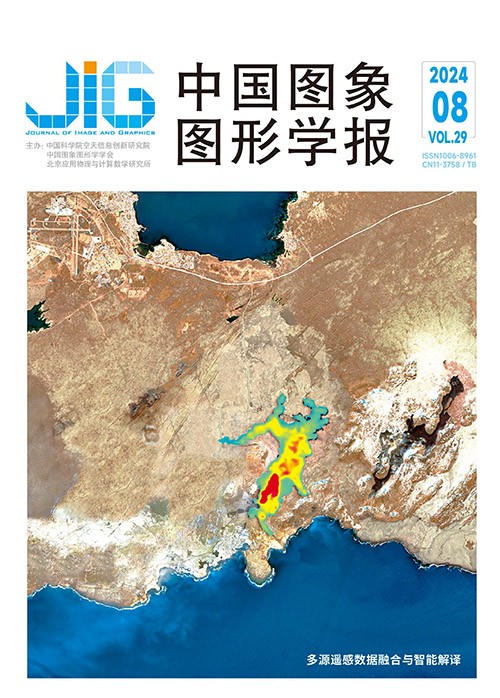
融合特征优化的跨数据集高光谱图像分类
摘 要
目的 高光谱图像分类可实现对地物目标的逐像素识别,是对地观测中的关键技术。由于采集环境变迁与成像设备差异等因素的影响,不同高光谱图像特征分布偏移,影响现有模型的跨数据集分类精度。针对此,提出了一种融合特征优化的无监督跨数据集高光谱图像分类方法。方法 提出了基于奇异值抑制的特征均衡策略实现数据内独立优化,通过限制奇异值正则项兼顾特征的可迁移性与可鉴别性;提出了基于隐式增广的特征匹配策略实现数据间特征协同优化,引导源域特征逼近目标域提高模型的泛化性;设计了基于隐式鉴别器的对抗学习框架实现数据间特征类别级优化,提高了预测多样性,实现跨数据集分类。结果 实验在Pavia数据集组和HyRANK数据集组上进行,与多种最新的跨数据高光谱图像分类方法进行了对比,在Pavia数据集组中,相比于性能第2的模型,总体精度、平均精度和к系数分别提高了1.75%、3.55%和2.17%;在HyRANK数据集组中,相比于性能第2的模型,总体精度、平均精度和к系数分别提高了6.58%、13.10%和7.96%。同时进行了消融实验,研究了各个模块对高光谱图像分类效果的影响。实验结果表明,每一模块在提高高光谱图像分类效果方面都是有效的。结论 本文提出的融合特征优化的跨数据集高光谱图像分类方法可以在无监督的条件下显著提高跨数据集高光谱图像分类精度,提高分类预测的多样性,得到更好的分类效果。
关键词
Cross-dataset hyperspectral image classification based on fusion feature optimization
Ma Xiaorui1, Ha Lin1, Shen Dunbin1, Mei Liang2, Wang Hongyu1(1.School of Information and Communication Engineering, Dalian University of Technology, Dalian 116024, China;2.School of Optoelectronic Engineering and Instrumentation Science, Dalian University of Technology, Dalian 116024, China) Abstract
Objective Hyperspectral image is a 3D data cube of “space-spectrum integration”. Its high-resolution spectral information can realize fine-grained land cover identification, and its wide-coverage spatial information can complete accurate land cover mapping. Therefore, hyperspectral images with spatial information and spectral information are widely used in tasks related to land cover classification. Thus, hyperspectral image classification is an important research topic in remote sensing field and a key supporting technology for many Earth observation tasks, such as smart cities, precision agriculture, and modern national defense. In recent years, many classification methods for hyperspectral images have been proposed to mine spatial and spectral information based on different deep networks, and they have achieved unprecedented high-precision classification results. However, due to various factors such as the change in acquisition environment and the difference in imaging sensors, the feature distribution of different hyperspectral images is shifted, which leads to the difficulty of cross-dataset classification. For this reason, existing classification methods usually retrain the model to deal with new hyperspectral image dataset, which is label intensive and time consuming. In the era of remote sensing big data, developing classification methods for cross-dataset hyperspectral images is important. Therefore, this study investigates classification methods for cross-dataset hyperspectral images to achieve large-scale Earth observation missions. Method This study proposes an unsupervised classification method for cross-dataset hyperspectral images based on feature optimization. The proposed method consists of three main modules. First, a feature balancing strategy is proposed to optimize the intra-dataset features independently. During the adversarial domain adaptation process, the transferability and discriminability of features are contradictory, and most existing methods sacrifice the feature discriminability of target dataset, which results in blurred class boundaries and affects classification performance. In the proposed method, a regularization term with singular value of the feature vectors from the source and target datasets is minimized to enhance the transferability and discriminability of the learned features. By extracting better features, this method achieves more accurate classification results on the target dataset. Second, a feature matching strategy is proposed to optimize the inter-dataset features collaboratively. No labeled sample is available in the target dataset, and feature discrepancies are obvious between the source dataset and the target dataset. Thus, the model cannot accurately match the two datasets, which leads to inadequate generalization. In the proposed method, an implicit feature augmentation strategy is performed to guide the source features to the target space, which improves the generalization performance of the model. By utilizing the underlying relationships between different datasets, this method adapts better to the target dataset and improves the overall performance of the classification model. Finally, an adversarial learning framework based on implicit discriminator is designed to optimize inter-dataset class-level features. Existing adversarial learning methods often construct an additional discriminator or use a binary classifier as a discriminator. The former focuses only on feature confusion between datasets and ignores class-level information, and the latter considers only class-level differences, which leads to ambiguous predictions. In the proposed method, by reusing the task classifier as an implicit discriminator, inter-dataset alignment and cross-dataset class recognition are achieved. By further optimizing the adversarial learning method, this approach can further enhance the classification performance of the model on the target dataset. Result All experiments in this study are executed on a desktop computer with Intel Core i7 4.0 GHz CPU, GeForce GTX 1080Ti GPU, and 32 GB memory. PyTorch, which is a widely used deep learning framework, is used in the experiment. The experiments are conducted on Pavia and HyRANK datasets. The evaluation indexes include overall accuracy (OA), average accuracy (AA), and к coefficient. In addition, the classification results are intuitively represented by classification maps. The experimental results are compared with various recent classification methods for cross-dataset hyperspectral images trained with all labeled source samples and unlabeled target samples. The proposed method is optimized by a small-batch SGD optimizer with a momentum of 0.9. The learning rates for the Pavia and HyRANK datasets are set to 0.000 1 and 0.001, respectively. The maximum number of iterations is set to 2 000. In the Pavia datasets, OA, AA, and к values increase by 1.75%, 3.55%, and 2.17%, respectively, compared with the model with the second performance. In the HyRANK datasets, OA, AA, and к values increase by 6.58%, 13.10%, and 7.96%, respectively, compared with the second-ranked model. Experimental results show that, compared with other methods, the classification maps produced by the proposed method are closer to the ground truth, and evaluation indexes of some categories are significantly improved. Moreover, the ablation experiment is conducted to study the effect of each module of the proposed method, which proves that each module is effective in improving the cross-dataset classification effect of hyperspectral images. Conclusion In this study, a feature-optimized classification method for cross-dataset hyperspectral images is proposed. The proposed method provides a novel solution for unsupervised classification of cross-dataset hyperspectral images. By combining feature equalization, feature matching, and adversarial learning techniques, the method improves the generalization capability and classification performance of the model. Thus, it is an effective approach for cross-dataset image classification tasks. The proposed method is verified on two hyperspectral datasets, and the experimental results show that the proposed method can significantly improve the accuracy of cross-dataset hyperspectral images under unsupervised conditions compared with related methods.
Keywords
hyperspectral image classification cross-dataset classification feature optimization domain adaptation unsupervised classification domain adversarial network
|



 中国图象图形学报 │ 京ICP备05080539号-4 │ 本系统由
中国图象图形学报 │ 京ICP备05080539号-4 │ 本系统由